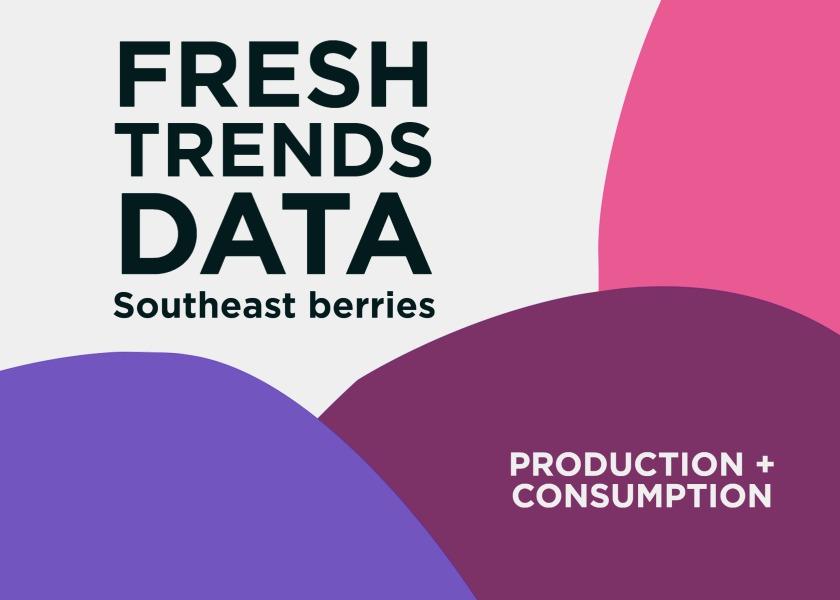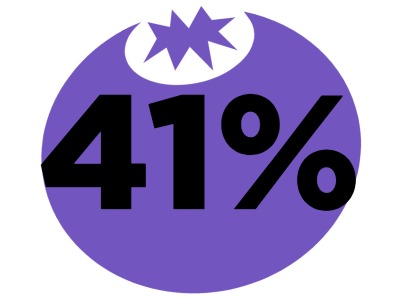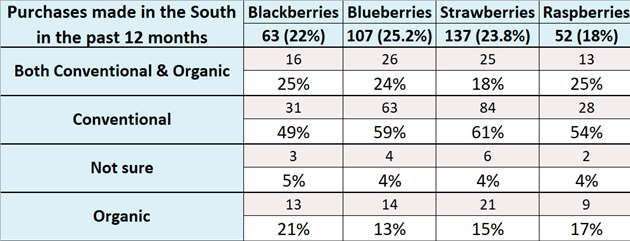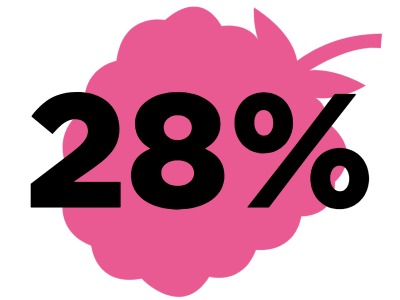Fresh Trends data on Southeast berry production, consumption

Berries tend to be fan favorites, especially around Valentine’s Day. Strawberries, for example, have long been symbols of love and fertility. And the heart shape of the fruit doesn’t hurt either.
Still, whether U.S adults are getting enough berries and other fruits and vegetables in their diets is another matter. Recently, Tom Karst, editor emeritus of The Packer, reported on data provided by the Centers for Disease Control and Prevention revealing that “just one in 10 Americans eat recommended levels of vegetables.” This also seems to be reflected in The Packer’s 2022 Fresh Trends survey results, which showed decreases in fruit and vegetables purchased as an ongoing trend.
Below is more data on the state of berries in the Southeast region of the U.S., as well as a few interesting facts and tidbits about the berries themselves.
Strawberries
According to the University of Florida Gulf Coast Research and Education Center, when strawberries were first cultivated in 1835, they were called “strewberries” because of the berries seemingly being strewn among the leaves.
 Of course, the name has long since changed, but the strawberry continues to hold firm to its recognition as one of the most popular fruits — especially in Plant City, Fla., regarded as the winter strawberry capital of the world because of being the dominant winter producer of strawberries in the U.S., according to the Florida Strawberry Growers Association website.
Of course, the name has long since changed, but the strawberry continues to hold firm to its recognition as one of the most popular fruits — especially in Plant City, Fla., regarded as the winter strawberry capital of the world because of being the dominant winter producer of strawberries in the U.S., according to the Florida Strawberry Growers Association website.
It should come as no surprise, then, that, according to the USDA’s Agricultural Marketing Services National Shipping Point Trends Report, as of Feb. 8, shipments from Florida’s central district movement are expected to increase and trading is “very active.”
In The Packer’s own annual Fresh Trends research, strawberries recently pushed their way from the third spot to the No. 2 most-purchased fruit. That’s despite the 56% of respondents saying they have purchased strawberries in the past 12 months being down 2% from last year.
Read related: Why strawberries are the sweethearts of Valentine’s Day
Blueberries
In 2020, Florida blueberry acreage remained steady when comparing 2019 acreage. When compared to 2019 numbers, Georgia’s blueberry acreage was down slightly in 2020 to 4,640, according to the USDA Economic Research Service’s annual berries report.
Georgia’s blueberry acreage was down slightly in 2020 to 4,640, according to the USDA Economic Research Service’s annual berries report.
According to The Packer’s Fresh Trends data and research, approximately 41% of survey respondents said they have purchased blueberries in the past 12 months. Of those individuals, 25.2% came from the South.
Look at the 2021 berry purchase patterns of Southern grocery shoppers according to the Fresh Trends Data.

Blackberries
 The blackberry is a type of caneberry, and “yields in many areas of the country may exceed 6,000 (pounds per acre),” according to the University of Florida’s Institute of Food and Agricultural Sciences, noting that “quantitative yield data from Florida are scarce.”
The blackberry is a type of caneberry, and “yields in many areas of the country may exceed 6,000 (pounds per acre),” according to the University of Florida’s Institute of Food and Agricultural Sciences, noting that “quantitative yield data from Florida are scarce.”
According to our Fresh Trends research, 26% of respondents said they have purchased blackberries sometime in the past 12 months; of those, a quarter were from the Southeast.
The blackberry is also the state of Alabama’s official fruit. As such, “blackberry farms thrive in Georgia, with harvest peaking in mid-June,” according to Georgia Grown, a marketing and development program of the Georgia Department of Agriculture. “Despite the ease with which they produce fruit, blackberry patch lifespan is only seven years.”
Here is a map of blackberry production by state. The farms indicated have 10 or more acres.

Raspberries
According to the UDSA National Agricultural Statistics Services, “utilized production (of raspberries) in 2018 totaled 217 million pounds, down 1% from comparable states in 2017.” Of those, “132 million pounds were for the fresh market.”
million pounds, down 1% from comparable states in 2017.” Of those, “132 million pounds were for the fresh market.”
In 2020, raspberry production equaled about $395.3 million for the fresh market, according to USDA NASS. That number is up 3.7 % from 2019.
According to our Fresh Trends research, 28% of those who took the study said they had purchased raspberries within the past year and a quarter of those surveyed lived in the South.







